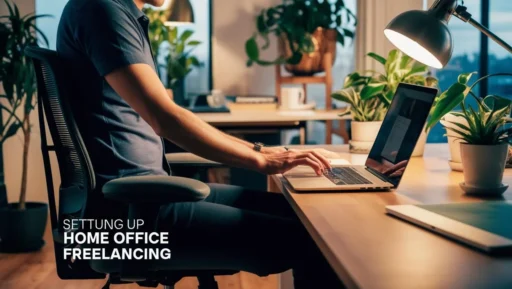Creating a Productive Freelance Environment at Home
As a freelancer, your workspace is more than just a desk and a chair; it’s the command center of your business. The environment you create has a profound and direct impact on your productivity, focus, creativity, and even your mental well-being. Unlike traditional employees, you have the unique opportunity—and the crucial responsibility—to design a workspace that is perfectly tailored to your needs.
A thoughtfully designed home office acts as a powerful psychological tool. It helps you create a vital separation between your work and personal life, maintain a high level of professionalism during client interactions, minimize costly distractions, and foster the deep focus required for high-quality work. This guide will walk you step-by-step through designing, equipping, and optimizing a home office that not only supports but actively enhances your freelance success.
Step 1: Claim Your Territory
The first and most important step is to select a dedicated location for your work. This physical boundary creates a mental boundary, signaling to your brain when it’s time to be “at work.”
- Prioritize Privacy: A room with a door is the gold standard. A spare bedroom, a den, or even a large walk-in closet converted into a “cloffice” can work wonders. This shields you from the daily symphony of household noise and interruptions.
- Harness Natural Light: Whenever possible, position your desk near a window. Natural light is proven to boost mood, increase alertness, and reduce eye strain. Use adjustable blinds or curtains to control glare throughout the day.
- Avoid High-Traffic Zones: Setting up shop in the middle of the living room or next to the kitchen is a recipe for constant distraction. Choose a low-traffic area to minimize interruptions from family members or roommates.
No spare room? No problem. If a dedicated room isn’t an option, get creative. Use a bookshelf, a folding screen, or even a strategically placed plant to visually partition a corner of a larger room. The key is to create a space that feels separate and is used exclusively for work.
Step 2: Build Your Cockpit for Comfort and Health
You will be spending thousands of hours in your office chair. Investing in ergonomics is not a luxury; it’s a non-negotiable investment in your long-term health and a preventative measure against chronic pain and repetitive strain injuries (RSI).
- The Desk: Choose a sturdy desk with enough surface area for your computer, keyboard, and essential items. Don’t underestimate your need for space. If you’re looking to combat a sedentary lifestyle, consider an adjustable standing desk or a more budget-friendly sit-stand converter that can be placed on your existing desk.
- The Chair (Your Most Important Investment): If you only splurge on one item, make it your chair. Look for a high-quality ergonomic chair with adjustable features:
- Lumbar Support: To support the natural curve of your lower back.
- Adjustable Height & Armrests: To ensure your feet are flat on the floor and your elbows are at a 90-degree angle.
- Seat Depth & Tilt: To provide proper thigh support and allow for comfortable reclining.
- Monitor Placement: To prevent neck strain, your monitor(s) should be positioned so that the top third of the screen is at or just below eye level. A good rule of thumb is to place the monitor about an arm’s length away from you. Use a monitor stand or a simple stack of books to achieve the correct height.
Step 3: Master Your Lighting
Poor lighting is a primary cause of eye fatigue and headaches. A layered lighting strategy keeps you alert and comfortable.
- Ambient Lighting: This is the overall light in the room, provided by a ceiling fixture or floor lamps.
- Task Lighting: This is focused light for your work area, provided by a good-quality, adjustable desk lamp.
- Light Temperature: For daytime focus, use bulbs with a cooler, blue-toned light (5000K-6500K). In the evening, you can switch to warmer tones to help your brain wind down.
Step 4: Conquer the Clutter (Physical and Digital)
A cluttered workspace leads to a cluttered mind. Organization is key to efficiency and a calm mental state.
- A Place for Everything: Use drawers, shelves, and desk organizers to give every item a home. Keep only your daily essentials within arm’s reach.
- Tame the Cable Monster: Tangled cords are unsightly and unsafe. Use velcro ties, cable sleeves, or an under-desk cable management tray to organize your wires.
- Digital Organization: Your digital workspace matters just as much. Maintain a clean desktop, use a logical folder structure for your client files, and utilize a bookmark manager to organize your most-used websites.
Step 5: Equip Your Office with Professional-Grade Tech
Your technology is what allows you to deliver your service. Ensure it’s reliable and professional.
- High-Speed Internet: Fast, stable internet is non-negotiable. Consider having a backup plan, like a mobile hotspot, in case of an outage. Business continuity is your responsibility.
- Quality Webcam and Microphone: Your audio and video quality during client calls directly impacts their perception of your professionalism. An external webcam and a USB microphone are a significant upgrade from your laptop’s built-in options.
- Data Backup System: A hard drive failure could wipe out your entire business. Follow the 3-2-1 Backup Rule: at least 3 copies of your data, on 2 different types of media, with 1 copy stored off-site (e.g., in the cloud).
The Final, Crucial Step: Building the Wall Between Work and Life
Your home office’s most important function is to help you separate your professional and personal lives. This is crucial for preventing burnout and maintaining your mental health.
- Create a “Commute”: Since you don’t have a physical commute, create a ritual to signal the start and end of your workday. This could be making a specific cup of coffee, changing from “lounge clothes” into “work clothes,” or taking a 10-minute walk around the block before you start and after you finish.
- Leave Work in the Office: When your workday is over, leave it behind. Turn off work notifications on your phone. Avoid the temptation to check your email “one last time.” Physically leaving your office space and closing the door is a powerful psychological cue.
Conclusion: Your Office is a Business Investment
Creating a dedicated, well-equipped home office is not an indulgence—it is a foundational element of a successful and sustainable freelance business. It is a statement to yourself, your family, and your clients that you are a serious professional. The effort you invest in your workspace will pay dividends in the quality of the work you produce and, most importantly, in how you feel at the end of each day. Treat your office as a living, evolving part of your business, and it will become the engine that powers your success for years to come.

